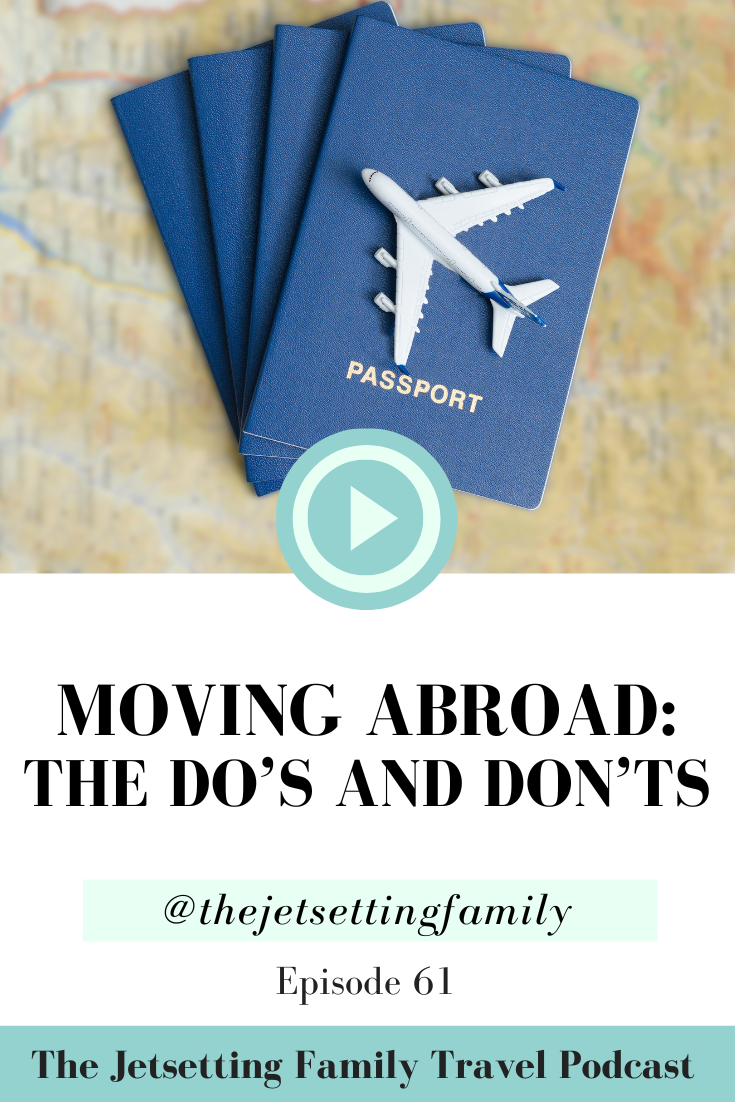We recently moved from the US to Mexico, and wow have we learned a lot (and made a lot of mistakes)! In this episode we cover all the logistics associated with a move abroad – from transportation, to immigration, school, and bringing a pet along. Check it out!
Listen and Subscribe on: Apple Podcasts, Spotify, Google Podcasts
Transcript
Rod: Welcome to the Jetsetting Family Travel Podcast. I’m Jess. And I’m Rod.
Jess: And today we’re talking all about moving abroad.
Rod: We recently had quite the adventure. It’s been a couple of months in planning and finally made it through. We are here in Mexico and over these past couple of months, we have learned so much about what it takes to move abroad.
I think for us being full time travelers, we were moving back then when we used to travel full time, we were moving every week or so, but it never felt permanent kind of like this does even if this might not necessarily be permanent. This is a longer term move where we have to do a lot of preparation in terms of making sure that we have the kids ready with a good school that Simba our dog who was coming with us was all set to go. So it was quite the logistical challenge, I think.
Jess: I feel like this move was actually Harder in some ways than the full-time travel journey, because like Rod said, it’s more permanent. So when we left to full time travel, we really only plan the first stop in Hawaii. And my thought was always kind of like. Well, if I don’t like the Airbnb or if we don’t like the location, we’ll move.
Like there was never this sense of, I have to make sure it’s the perfect fit because we’re signing a long-term contract. It was kind of like, well, oh, well, if the place sucks, we’ll deal with it for five or six days and move on with our lives. So this time it was just, there was a lot more logistics and a lot more.
Planning involved. And so we’re going to kind of go through if you’re deciding to move abroad, what are some things that you should be considering, as far as logistics. So we’ll start with visas for one. Every country has different requirements. So this is something you will need to do your research and do it early to decide how long is it.
That you can stay, and you just need to be careful because even if typically, you know, coming to Mexico, for instance, typically Americans get six months. So it’s easy to be like, well, I’ll stay five months, go back to the U. S. and then come back in. But that can get tricky depending on what you’re doing while there.
So for us, for example, our kids, we wanted them to be enrolled in a school and all of the schools here required that you had proof of a student visa or some sort of citizenship. And so our had planned to just leave it as like U. S. citizens changed quickly. And it was easier for us because Rod and I are both Mexican citizens, so it was easier for us just to acquire our kids’ Mexican citizenship.
For them, to meet that requirement, then going through the visa application. And it’s something they’ll have for life, but that was something I really didn’t consider. So every country you go to, we’ll have different requirements. And don’t just think because the length of time as an American, you can go back and forth because school and work requirements might require a different type of visa, and sometimes those take months to apply for, and it’s something you need to start early on in the process.
Rod: Yeah. So I think knowing what your visa limits or requirements are is going to help you figure out when do I need to set my move in date. For us? Our move in date was really guided by the kids’ school schedule So our kids finished their year of elementary school in Florida at the end of May, and we knew that here in Mexico, they were starting at the end of august So we had to make that transition somewhere between May and August And that’s, I think that’s where the next topic comes in, which is transportation.
How are you getting to the country that you’re moving to? I think this was a oversight. Yeah. It was a big challenge for us because we, we, we are used to traveling and we thought it would be easy. It’s like, okay, we’ve moved places before this should be fine. However, for us. This was the first time that we were really making a big move with our dog, Simba.
And even then, we thought, okay, we’ll just put him on a plane and, you know, we’ll get to our destination. Turns out it’s not that simple. I mean, it could be simple if your dog is small and they can fit in your lap or under the seat. Right. But for our dog, he’s a giant Schnoodle. He’s like 70 pounds. He’s very tall.
So then finding the right fit of carrier for him was a big challenge. And we
Jess: Most airlines will not take his crate size. Yeah.
Rod: It has to be able to fit inside like the cargo door of the specific airplane that you’re going into. So we, where we were flying from the plane that was flying from there.
We, we couldn’t get that kennel to go through it. The other issue is there are certain temperature limits. So if you’re flying out of an airport that has hot weather, or if you’re flying into an airport that has hot weather, then, if you don’t meet those weather requirements then they can’t fly your pet in cargo.
So that was the other risk is if we all buy our tickets and our dog doesn’t make it because it’s too hot, then, you know, what, what were we going to do?
Jess: So for us, it was more challenging because we were flying from South Florida to Mexico. They were both very hot destinations and the requirement was it had to be cooler than 85 degrees.
Which realistically for departure and arrival for us would have been not till like November and we would have had to come back by like February or March. It was very unrealistic. So these are things I honestly looked into our flights like two and a half, maybe two weeks before we flew out and was like, Oh, we’re just going to get the plane.
And then it’s 150 to put your dog in like the luggage compartment. Thought nothing of it. I called the airlines and I was in for like a panic attack of like, there’s no way we can take him until November. We’re trying to leave in August. And so it was this big whole commotion of now are we driving?
What are our options? And so if you’re traveling with a pet, definitely research your options. I would say anywhere from four to six months out, because you need to start looking for logistics. And I really discovered that pet transfer services are extremely, extremely expensive. I was shocked at the prices.
We looked into a service that’s well known here in Mexico, where someone drives your pet for you. It was, I forget best friends, movers or something, and they drive your dog. They quoted me 7, 000 to drive Simba from Florida to Mexico, like just him, not us, not our belongings, just him. And another quote to have him flown on like more of a cargo type airplane was going to be 5, 000.
And both of these options just seemed crazy to me that we would pay that much for him to go and not include us, not include our luggage. And so we really had to get creative with how we were going to make it to Mexico. And I think some of that could have been curved or at least logistically plan better.
Had we known in advance that this was going to be a major hurdle.
Rod: So we settled down basically on 2 potential options. Option. Number 1 was. I would drive with Simba across the US to the Mexican border through Mexico to get to our destination, which would’ve taken days seven, seven days. Yeah. It would’ve taken a long time, but they would’ve been, I think the pros for that were we could pack our car, we would have our car there, and then we could put more things in it and.
It would be less expensive, less costly than the other option, which ended up being we could charter a plane.
Jess: Which we laughed at when the idea got thrown out. We were like, we’re like,
Rod: We’re never going to do this. This is ridiculous. It’s going to be really expensive.
Jess: And it was really expensive, because that is the option we chose.
But we found what’s called an empty leg flight, where the flight was going to fly. From our starting point to our destination. Ironically, during that same week empty to pick up a true paying passenger who pays a very high price. And in order to, I guess, make up for the lost costs, they rent the plane out for much cheaper.
We ended up, I mean, not to, it sounds crazy that we spent this much, but it was 6, 000. But I looked at it like it was 7, 000 to drive some of their, it was 4, 000 just to ship some of their for 6, 000. The 4 of us, Simba, and all of our luggage, they let us pack the plane with anything we wanted to take. Made it quickly definitely won’t charter planes just for a random vacation for the move.
Logistically, it made sense on our behalf. Rod probably could have done the drive. He was willing to do the drive. I was nervous. There were a couple things going on at the border at that moment. There was talk of protest and so I just said it wasn’t worth the risk. I’m sure it would have been perfectly safe, but I don’t know.
Rod: Yeah. Yeah. I mean, that’s, that’s what we chose and we never know what could have happened if it would have been fine or not. Probably would have been fine. A lot of people drive on those roads every single day, but That that private charter experience. Let me tell you that was so nice. Yeah. Just being able to show up at a private terminal.
You see your plane right there. You’re greeted by your flight attendant. You have all your stuff with you and they load it all into the plane. They really don’t touch your luggage. Yeah. They’re like, Oh, you’re here. We could probably leave a little bit earlier if you’re okay with that. So then it’s like, all right, we just walked out.
Of the terminal into the plane directly. We met our pilots there, um super comfy, took off. And we were there like just super quick.
Jess: And since it flies above commercial airlines, like the higher you go in the sky, the smoother it was, there was like not a single turbulence. There was no bumps. And then. It was nice too, because when we arrived, we had like, you don’t go to the main airport.
You have like a private plane airport. And so we had customs immigration and then a dog inspection, but it was like just us and the workers. So, I mean, it happened in like 5 minutes and they had someone carry our luggage the whole way. I mean, it was.
Rod: Yeah, that was like the smoothest travel day that we could have planned.
We did pay for it.
Jess: We realized that’s not an option for everyone, but if you, if had we planned in advance enough, I don’t know how much it would have changed our outcome, but if you’re moving to Europe, I did so much research on flying with. Dogs. There’s a couple airlines that are not private charters, but they’re semi private, so they’re much, much cheaper that take large dogs.
So like maybe you and one family member could fly on or you and your dog could plan that and the rest of the family flag. economy. There’s JSX was one in the U. S. that flies with dogs. There’s, um Facebook groups that do shared chartered planes. So you’re just buying one seat and your dog. So there’s a lot of options, but all of these would have taken planning way out in advance that I didn’t do.
So don’t make my mistake. If you don’t want to be scrambling at the end and you’re traveling with an animal plan in advance and going into that traveling with an animal has its own set of requirements. And every country will be different for us. We had to get proof of a rabies vaccine. Yep. We just
Rod: have to get his vaccination record.
There’s the thing with Mexico is a lot of things feel very unclear in terms of what the regulations are. We had read. That yes, health certificates are needed. And then we read, oh no, actually as of 2019 or 2021, I forgot the year that they’re no longer needed, but your pet will have to go through a pet inspection and they’ll have to make sure that they’re cleared either at the border checkpoint or at the terminal at the airport.
So we ended up just getting a health certificate just to play it safe. We had all this vaccination records ready to go. We brought, a couple of baggies of food just to make sure that we had enough food to get here and a couple of days before we needed to get him new food, but I think there were regulations there too, where they technically could have searched our luggage.
And they did search our luggage, but they did see dog food there. It was in a Ziploc bag and we told them this is for the day or the next couple of days. And they seem very fine with that, but it very well could have been interpreted differently depending on the airport or the checkpoint that we were at.
Jess: So did they ask for the health certificate? They did. Yeah. Okay. So they did ask for it and you had to have proof that your dog had been on heartworm medication for. Or was on a current treatment plan. Right. Something to keep in mind. And then they did physically inspect him for ticks, fleas, and any sign of.
I don’t know a medical condition. They didn’t have a physical dog inspector there. But at least it was really quick and we got through some countries are going to require that your dog quarantine possibly, or they might have other requirements.
Rod: Yeah. Some of them might ban certain dog breeds too. So you need to be very clear on what those regulations are.
So that you don’t have any challenges on the day of getting there.
Jess: And something to consider too is not only what are the requirements to get your dog into a country, but what are the requirements coming back to the USA from that country? Like right now the USA has several countries where I’m not sure if it’s a quarantine or a band completely, if a country is considered rabies infested or like has a rabies pandemic of some sort.
Mexico was not on that list. And so I, at this point, I’m pretty confident unless we get added to this list during our year here that we can take Simba back without a problem, but you just need to make sure you’re not only looking into what the requirements are going to the country with an animal, but like, what is the rest requirements coming back?
Cause you would never want to go to a certain country. If you’re going, especially only for a year. And then have to leave your dog behind. So make sure you look at it on both ends of your trip.
Rod: Yeah. Yeah. I think the other thing relating to pets and something that we looked at was what are the requirements for service dog status?
So making, if we had Planned more time if there was a disability or a challenge that we wanted to get service dog certified for Simba, then that may have made it simpler to travel through the airport. But when it comes to also foreign countries, service dog status, I think it’s something that is cleared both by the airport and by the immigration team.
So I don’t know what that that would have been, but. That’s something to consider if your dog is a service animal, then you do have a little bit more flexibility in bringing them into the main cabin of a flight. For, for those types of situations.
Jess: Yes. Just make sure, when your dog is a service animal and two, they’re really well trained that you’re comfortable that they’re going to behave in public as they should.
Yep. So next up is schools, schools. We have gotten the most questions, I think on Instagram, at least about schools and how did we find the school and what did we do? And this is goes into both schools and what we’ll talk about housing in a minute is. Really rely on Facebook groups is what I have found to be the most beneficial.
If you search Facebook, you can search whatever city you’re going to, or if you can’t find that specific city, like the state, but usually you can search the city and put that city in and put the word expat or put local. Whatever, like local Tampa residents or expats in London or whatever it may be.
You’re going to put your city name and like local expats or find some sort of. Mothers or women of group and that you will join the group or parents or dads. It should not be that easy, but you can search, join these group and I always before you ask the question search like the word schools or recommended schools and see if there’s past threads.
If not, make a post like, hey, we’re considering moving to this area. Do you have any school recommendations? And you it’s best to hear from the locals. I found my best information on these groups, of just what people thought. Some people had gone to some of these schools and decided it wasn’t a great fit for them and switched.
Maybe that great fit for them has nothing to do with my kids. It doesn’t mean the school is bad. Maybe, I don’t know, their kid is extremely musical and they didn’t feel that that gift was being nurtured. I don’t know. But these schools, or these Facebook chats really give you an idea of what schools you might want to consider, what schools you might want to avoid.
And then from there, we went out, we did our tour of schools back in February and March timeframe. Yep. So this was a way in advance. This is before we had even made the decision if we were moving. At the time I was building Nora’s bed. So I definitely didn’t really truly have that in my mind, but we thought, hey, this is something we’ve considered for years while we’re here.
Let’s just check this out. And we went to, I think four schools, four or five schools. And for me, everyone’s asking what my requirements were for me. It was more of a feeling. I think we really wanted to go into the school and see that the kids were really happy. It was like, paying attention to like, what were the expressions of the children who were there?
Did it seem organized? And like, what was kind of. I don’t know the general feel was administration, like really kind. Did the teacher seem kind with the students? It was more of an overall feeling. And I’d say like out of the four or five schools we went to, we’ve really liked two. Yep. There was one that was an absolute no.
I don’t know what was going on at that school. It felt like a prison. And every kid looks sad.
Rod: We will not be there within the first 10 minutes. It’s like, this is not the right fit.
Jess: She was like, do you want a more detailed tour? No, thank you. But there was two schools that were a good fit. And it was interesting because one of the schools that was, I thought a good fit.
I really thought Nora would have thrived at particularly. But Santi might not so much. It was a very artsy school. It was more of that Waldorf, like, I don’t know, go at your own pace. It was just, it was a different model. And I thought Nora would thrive there, but Santi wouldn’t. And so the school we ended up picking was the place that I thought was like a happy medium.
That both kids would thrive at. And I really wanted them to stay together.
Rod: One of the big things that we were also looking at was, I mean, just for background, our biggest goal of moving here to Mexico is for our kids to become fluent in Spanish. So every, every country I think, or most countries would have international schools at certain cities where you can put your kids in school and they can have English education so that it’s easier for them to make that transition.
For us, we specifically did not look at international schools because we wanted to put them in a program where there was a certain level of Spanish speaking, and that way they can get immersed in it in school, and it would kind of accelerate their ability to learn and become fluent in the language.
So, we ended up picking a school that was it is bilingual, so it spends about half the time in Spanish, half the time in English, and we thought that that was a good kind of middle ground for the kids to have some comfort in their native language, but also be very exposed to Spanish and learning how to read it, speak it, and really understand it.
Jess: And I think something at this school that stood out to me was probably the main push while I picked it is I was really impressed when we did the tour that the administration had said, you know, they did get quite a few kids who did not speak Spanish every year and that they have found that the transition can be tough. And so this school made you sign a contract and required that our kids are going to stay after school, several days a week with a tutor. Who’s also a teacher at the school to help translate their homework for them or help move them along in like a private Spanish lessons. Rod and I speak Spanish, so it’s definitely something we can do at home, but like our kids with us, it’s hard to explain.
I really regret not just speaking Spanish to them since they were little. Nora, Nora will be like, just speak to me in English. So she gets frustrated and she resists. And as a parent, it’s just so much easier to give in. So I really liked that this was a program that they have. So all of the kids who do not speak Spanish will stay after school, depending on their Spanish level going in.
I think it’s anywhere from one to three days a week is the requirement, to help catch them up. And I think it reduces as they improve. And so I liked that they had this structure and when we go to the school, it’s interesting because, I’d say it’s 80% Native people from here, Mexicans, and then there’s probably about 20% international.
So it’s kind of like an international school, but a local private school. But we have met families from Russia, France, Canada, South Africa, Spain, Argentina. Like, all over, I mean, people at this school are from all over and it seems like every class, it’s about 80% local, 20% international. And so a lot of these kids are learning Spanish.
There’s several Russian kids I’ve met who don’t know English or Spanish, and they’re kind of learning both as they go. And so, I think. It was a good fit for us.
Rod: Yeah, and the other thing to discuss is really timelines. Our original plan was to move to Mexico sometime in either December or January of 2024.
And when we started touring these schools, and we were letting them know, oh, we’re thinking of coming around this time. They were very clear with us. They said it it would be very unlikely for us to have space to accommodate or to enroll your children at that stage or at that month or timeline. So then that’s when we ended up looking.
Okay. Well, it sounds like we need to move our plans up, which really accelerated everything for us because we knew we needed to enroll them right away to secure their spot or else risk showing up here in January and not having a. Or at least the school that we wanted for them to enroll them in. So,
Jess: Yes, we didn’t realize that we kind of thought, Oh, we’ll come at Christmas break and stay through July.
And then when that time, hopefully they’ll learn a lot of Spanish, but that definitely changed our timeline. So when we were here in March, you know, we thought we had till January of 2024. And all of a sudden, they’re like, no, you need to move here in July. We were like, what? And so. For us, we wanted to make sure it was this year because this is the year, this is Santi’s fifth grade year.
And we really wanted to do this before he went into middle school, but we just weren’t anticipating such a rush timeline. And we enrolled the kids officially and they were still in school in Florida. So it was in April or May is when we officially enrolled them in school and Santi got the last spot in fifth grade.
So. That was like, he was like the last student to be admitted for the fifth-grade season of the year. So definitely if you’re looking at wanting to go to like a good local private school or just a good like chart, like something that’s not a public school during your move, that is something to keep in mind that these schools seem to book out really far in advance and you definitely want to get a spot and really know.
What the requirements of that school are. The requirements at this school to get prepared was probably the most exhausting part of our move between, I don’t know, they had to have their either their student visa or their past or like their Mexican residence number done, to try to get their uniforms.
It’s like a very small window of time. This school required, that they do an evaluation with both English, Spanish, and a psychologist before going. So they actually missed a day of school in Florida. Thankfully they ended up doing this all remotely, but like there were just a lot of requirements that they needed an
Rod: official report card, which in Florida, there’s not like.
Here is your official, notarized, signed report card. It was just, we went to the school and they gave us a printout of their current grades. They do everything on the line. Right. So, that was, that was a little challenge that we had to…
Jess: In Mexico, everything is like sealed with these like golden, like, they look like royal papers from like, I don’t know, the King of England,
Rod: they’re like officially signed and stamped. So then it’s, it’s very intense. It’s all driven by the department of education here. A lot of the education here is centralized. So the calendars, the school calendars. For the entire country are the same, whereas in every school district in America is going to have a different schedule.
So that’s what made it a little bit more interesting and made it easier to plan for, but also a little bit more intense when it comes to getting them enrolled.
Jess: I first sent them like screenshots from like the online website. And the lady was seriously like, what is this? So then I asked the school, I’m like, they need something more official.
Well, they just legit printed the screenshots. And she’s like, that’s the same thing. It’s printed. And I’m like, I don’t know what I was, can you email the school? Can you call the school? Like the Florida school does not have a golden seal that looks legit. I don’t know what to tell you. So it’s just different requirements, a lot of different paperwork involved, a lot of things to make sure the vaccines are the same.
Like, I don’t know. It was just. A lot of logistics that went into play and so the school part is like the dog part something at least 6 months out. I would be trying to research.
Rod: Yeah. So I think overall theme of moving to a foreign country is you have to be ready to tackle any challenges that come up.
You have to be patient with the process, but at the same time, persistent with making sure that you’re getting what you want for your whole family. And now we’re here, you know, we’re renting a home. The home itself has its own set of challenges here, since we had family come and check out the house for us.
We didn’t actually see it or tour it in person before we rented it. So now that we’re here, it’s a great home and we’re starting to make it our own for these next couple of months while we’re here, but it’s been its own set of challenges too.
Jess: And that was another area guys for the house hunting. I heavily relied on the Facebook groups and posting like, what is the safest name?
Neighborhood for kids. What neighborhoods have the best amenities or what neighborhood has kids running outside the most. And so it was a lot of Facebook research. For us, it was trickier cause we didn’t have as much time here to actually go and physically see the neighborhoods ourselves. And so we kind of heavily relied on just the opinions of others.
And then when my parents were had come for a vacation here, I had a couple homes that I wanted them to see. So we contacted a local realtor and had them set that up for them and they ended up only seeing, I think 3 homes all in 1 neighborhood. I think had we had more time; I would have liked to have seen 2 or 3 homes in 2 or 3 different neighborhoods.
But overall, I’m really happy with where we’re at. We had acquaintances of family members who lived in this neighborhood and all had glory glorious things to say. But yeah, it was just, it was different because we looked for everything remotely. But I mean, if you’re doing a big move abroad and don’t have the time to be flying back and forth, it’s just kind of how you’re going to have to do it.
Thank God for FaceTime and Internet and things like that to help with making those choices.
Rod: Yeah. And in terms of our home in Florida, right, we had The option of do we leave it as is, do we rent it or do we buy it or if not buy it, sell it. We decided to rent it out. So making sure that the timelines for when people are moving in versus when we’re leaving, when we’re getting to Mexico, when we’re planning to leave here and go back to Florida, that that all aligns and matches up in a way that makes it financially possible.
Then, that’s the, the other or another challenge that you’re going to have to figure out.
Jess: So. Yeah, we ended up with a little bit of overlap, so we probably paid for a couple extra weeks that I wish we hadn’t, but we just wanted to make sure when we got, when we left Florida, we had like a little bit of wiggle room on the actual move out date.
And so I think, when we left Florida, our home stayed vacant for a tiny bit. And when we, before we moved here, we had access to the home for like 2 weeks before we got here, but just. That alleviated a lot of stress knowing if we weren’t ready or if something happened, like I got COVID the week before the move.
So that wasn’t ideal. I was quarantined upstairs with Santi, Rod’s packing the house. I couldn’t really help much. And so I think what left me relaxed and just kind of recovered is knowing, okay, this is our set move out date. But if that doesn’t happen. We have some wiggle room to, to be here an extra week if need be.
And thankfully he and Nord didn’t get COVID because we were really nervous. We’re like, do we book this flight?
Rod: Okay. What are we going to do?
Jess: But they stayed healthy. Thankfully. Other logistics is transportation. Once you’re here, if you’re going to Europe, I would say public transportation is a great option in most cities.
Totally depends on where you go for us right now. We are just going to be renting cars. I think we’re looking into buying 1. apparently, the car market in Mexico. The used car market’s very different from the US where a lot of times you could buy a used car and resell it a year or 2 later. For a very small loss so it’s something we’re considering but we haven’t really figured that out.
Had we driven here? That was an option for Mexico. We were, we heard 2 sides. Some people said not an issue. And some people said I would worry that just having us plates here made you more of like a theft target.
Rod: Yeah. And the process to register the car. From the U. S. to Mexico is a very extensive one required a lot of import fees that we weren’t really willing to pay for moving for such a short amount of time.
We would have kept the American plates. You can have a temporary import of a foreign vehicle for up to 6 months, I think, and you might be able to renew that if you want. But that’s something to look into certainly is do you want to ship your car? If you’re going to Europe and you want to ship your car there, you probably can.
You just need to look up who the carriers are, what the regulations are for that country. So that you are good to go there.
Jess: Yes. So we were kind of recommended by locals. And I mean, I think either way would have been fine to either get the temporary import visa and bring our car or a lot, a lot, a lot of people recommended buying like a used beater car, using it for a year and reselling it.
And I guess that’s a big thing that people do here. So that’s our plan. We’ll see how that goes. But overall, I will say logistics of this. Okay. We’re daunting. I think some of our neighbors in Florida, when we were, when we came back in March and we’re like, I think we’re going to move in June or July.
We’re like, what because it was a super short time span. I think it was time span. I think had we come in January, like we originally planned, it wouldn’t have seemed so rushed or like overwhelming at times. But now that we’re here, I’m glad we did it all. Yeah.
Rod: Yeah. Now we’re settled in and we get to actually. Yeah. Enjoy, explore, the kids get to learn and see this beautiful country.
Jess: There’s so much, guys. We’re excited to hopefully get to show you guys, Valladolid is a beautiful area in the Yucatan. Mérida is actually the safest city in all of Mexico and actually it’s rated now is one of the safest cities in North America.
So Merida is beautiful. There’s everything from Cancun, Playa, Tulum, Belize is close by. I mean, there are so many places in this region that you can get to quickly that are absolutely amazing that. It’s going to be an exciting year exploring. I’m hoping that we can take advantage of that. The Mexican school calendar, you have a three-day weekend every month.
So we’re going to try to utilize those to get out and about. Yeah.
Rod: Yeah. So if you’re planning your own move or considering it, we just went through it. So feel free to reach out. You can always find us at Instagram @thejetsettingfamily. And we’d be happy to help answer any questions. I know it’s always better being a part of a community where you can get the support.
And Jess has already talked about joining the Facebook groups or just reaching out to people that have done it. That helped us a lot, during this process.
Jess: So, and one last thing is I’ve had a lot of people say, like, I really want my kids to learn Spanish, but my job makes it really hard to leave for a year or those things.
Something you guys should consider if you want to do something like this, but maybe not so long term is summer camps. Mexico and Costa Rica and other countries have really cool summer camp programs. Most of those will be in July because their school year is a little bit different. But even like a four-week program in July, I think would be a great way for kids to be kind of immersed and have the opportunity to learn more Spanish.
Yeah. But we’re excited to bring you some episodes on Mexico. Maybe we’ll have one on the private flight experience, but we have
Rod: some other cool topics. And we still have some more northeast region cities that we visited this summer that we haven’t done podcast episodes on, so we’ll, we’ll get to those too, but…
Jess: Until next week, Happy Jetsetting!










